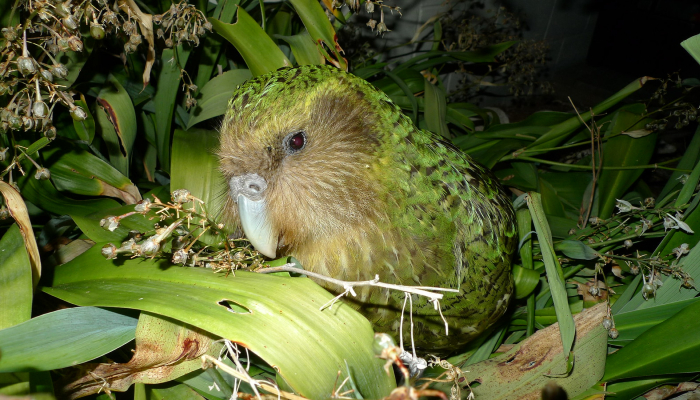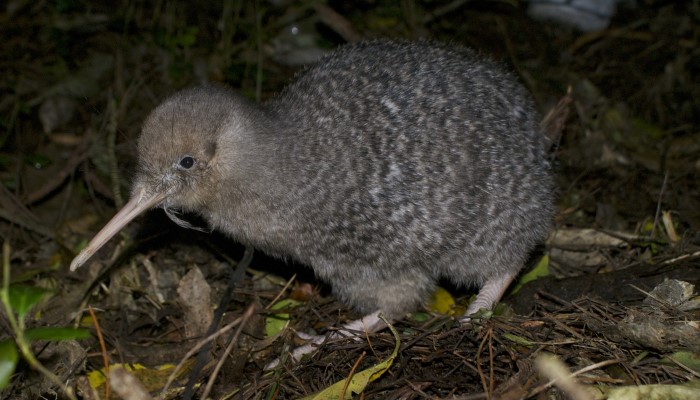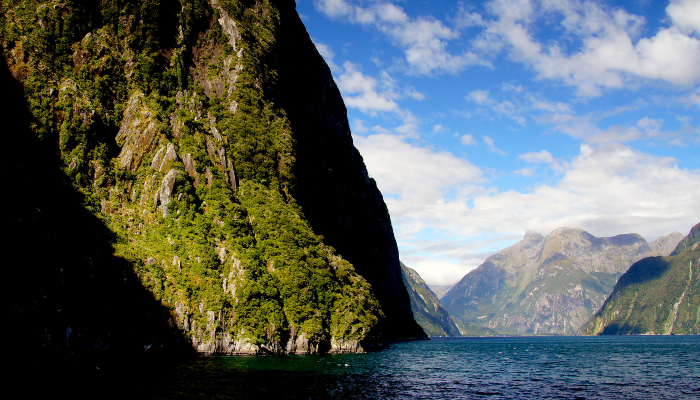New Zealand birds
Where can I find information about New Zealand birds?
(Years 7-10)

Image: Kakapo Sirocco by Chris Birmingham | Department of Conservation on Wikimedia Commons.
Entry last updated: 10/07/25
Introduction
Aotearoa New Zealand has many unique birds, from forest parrots to flightless birds, sea birds and birds of prey. In this entry we will show you how to find information about these birds, including their habitats, diets, adaptation, conservation, and communication.
New Zealand bird species
Here is a list of some well-known New Zealand bird species. Even if the bird you are looking for is not mentioned here, you will still probably find information about it in the websites we have gathered in this entry.
Pīwakawaka (Fantail): A small, common bird that you can recognise because its tail opens up to look like a fan.
Kākā: An endangered large forest parrot, at risk from predators like rats, possums, stoats and cats.
Kākāpō: A large, flightless, nocturnal parrot, the kākāpō is one of our most endangered birds.
Kea: A famous mountain parrot found in the South Island, known for being very intelligent but also very mischievous.
Kiwi: Aotearoa New Zealand's national icon. There are different species of kiwi, including the little spotted kiwi, great spotted kiwi, brown kiwi and more.
Kōkako: A blue/grey forest bird that is not very good at flying. The South Island kōkako is assumed to be extinct, but some remain in the North Island.
Ruru (Morepork): New Zealand's only surviving owl, this bird can often be heard in forests at night.
Karearea (New Zealand falcon): This bird of prey can fly over 100 kilometres an hour.
Pūtakitaki/Pūtangitangi (Paradise duck): One of our native ducks, this species mates for life and can be found in pasture, wetlands and grasslands. Penguins: Flightless sea birds, New Zealand has more species of penguins on our shores than any other country.
Pūkeko: A common blue bird found in wetlands and often seen along the side of the road. Pūkako can fly, but they prefer walking, wading and swimming.
Pūteketeke (Australasian crested grebe): A diving bird found in the South Island. They are well known for their courtship displays.
Takahē: A critically endangered flightless green and blue bird with a bright red beak.
Tūī: A common forest bird known for its beautiful song. Tūī have a distinctive white tuft under their throat.
Weka: A large brown flightless bird known for being a curious bird and a bit of a thief!
Kōtuku (White heron): A graceful white bird with a long neck.
Kererū (Wood pigeon): Also known as the kūkū, or kūkupa, this is a forest bird that you can hear flapping its wings because its body is so heavy!
General websites
These websites will help you find out about the native birds of New Zealand.
Te Ara: The Encyclopedia of New Zealand
Te Ara is one of the best websites to start with when you are looking at any topic about Aotearoa New Zealand. There's heaps of information about birds here, including images and media to go along with each story.
Go to the Sitemap for a list of all the sections on Te Ara.
Find Section: The Bush and choose Native Birds and Bats.
From here, you can find out about specific birds like the kiwi or the moa.
Or you can look at birds based on their habitat, such as wetland birds or forest birds.
This page also contains information about ngā manu and the importance of birds in Māori life.
Tips: We like websites with .gov or .govt in their address because they are reliable – they are from government organisations.
Department of Conservation (DOC)
The Department of Conservation, also known as DOC, is a government agency in charge of conserving New Zealand's natural and historic heritage.
Select Nature, and then Birds A-Z for an alphabetical listing of all the birds in New Zealand.
You can also go to Nature and then Habitats if you want information about the places that birds live.
Tips: Like Te Ara, this website also has a .govt in their address which means they are from a government organisation, so the information will be reliable.
New Zealand Birds Online is a searchable encyclopedia of New Zealand birds. On this website you will find heaps of info about birds, including extinct birds. This will include facts about habitat, population, ecology, conservation, images, bird calls, and links to more websites about specific birds.
Enter a bird name into the search bar eg Tūī.
Select the article you want to find photos, sounds, information and book lists.
Tips: Websites that have .org or .net in the address can have good information, but you need to assess how reliable it is. Check the About us link on the website, if you can find one. That can tell you what the organisation’s mission and values are. We trust this website because it is supported by Te Papa Tongarewa the Museum of New Zealand, Birds New Zealand, and the Department of Conservation.
This is the website of the Ornithological Society of New Zealand, which provides information and publications about New Zealand birds.
Select Publications along the top of the webpage then choose Notornis.
This is the scientific journal published by the Ornithological Society of New Zealand and contains lots of information about New Zealand birds.
You can download the latest publication as a pdf.
NZ On Screen - Nature Collection
This website has lots of documentaries that were made in New Zealand.
Look through this nature series list for documentaries about New Zealand birds, including the Little Black Robin, the Kea and The Black Stilt.
The videos Ghosts of Gondwanaland and Moa's Ark explore how New Zealand's isolation has contributed to our native bird evolution.
Conservation
Many of New Zealand's birds are endangered species because of the threats they face from humans, introduced species and habitat destruction. Some species are so threatened that they may become extinct in the near future, while others, like the moa or the huia, are now extinct.
Some projects and conservation efforts for specific birds are.
Kiwis for kiwi: The Kiwi Trust works with the Department of Conversation to protect kiwis.
Tiritiri Matangi Open Sanctuary: An island and conservation project near Auckland.
Sanctuary Mountain Maungatautari: An area near Hamilton surrounded by the world's longest pest-proof fence.
Zealandia: an ecosanctuary near Wellington.
The below sites talk about conservation of birds in New Zealand:
Forest and Bird are an independent New Zealand conversation organisation. Use this website to find information about bird conservation in New Zealand.
Select Resources and then Campaigns.
Look down the page to find Native Wildlife.
Here you can read about efforts to support native birds.
Tips: Websites with .org in the address can have good information but you need to check how reliable it is. Select the About Us link at the top of the page to find out more about the websites mission and values.
This is one of our favourite science-related websites. Here you will find lots of information about native birds and conservation, including nature reserves, the birds' role in ecosystems and the birds' predators,
Select Topics along the top of the page.
Look down to select Conservation.
Here you will find articles about native bird conservation like Birds roles in ecosystems and Takahē – an introduction.
Department of Conservation (DOC)
DOC also has information about New Zealand birds that are under threat.
Go to Nature and then Conservation Status.
Here you can find out the difference between at-risk species, threatened species, protected species, and a glossary of terms used when describing endangered species.
Look for New Zealand's threatened birds.
Te Ara: The Encyclopedia of New Zealand
Te Ara has information about conservation and threatened species too.
Revisit the Sitemap.
Under Section: The Bush, select Conservation.
There's lots of information here, including pages about threatened species, national parks, pests, human effects, and kaitiakitanga - guardianship and conservation.
Adaptations
New Zealand's isolated location has meant that many of the species of birds we have here evolved in unique ways. Try these sites to find out more about the physiological, behavioural and structural (or morphological) adaptations of New Zealand birds.
Google has worked with institutions, like museums, to put this site together. The mission is to bring art and culture from around the world online. It has general information about bird adaptations eg beaks and wings.
Search for 'birds adaptation'.
Look through the Stories for Adaptations of Birds.
If you look to the bottom of the page, you will see that the content comes from The Royal Society in London.
One of our favourite science related websites, Science Learning Hub has some excellent information about New Zealand bird adaptations.
Enter 'adaptations' into the search box.
Some of the entries you will find are Native bird adaptations which clearly explains the differences between physiological, behavioural and structural adaptations and Whio adaptations which talks about the whio/blue duck.
Extinction
Extinction means that there are no more living members of a species, and can be caused by a range of things, such as climate change or human causes such as hunting or habitat destruction.
Te Ara: The Encyclopedia of New Zealand
To find out about extinction of birds in New Zealand, have another look at Te Ara.
Enter 'extinctions' into the search box.
Go to the story called Extinctions.
This story gives a good explanation about what extinction means and what can cause it. There is also information about the extinction of large and small birds in New Zealand.
Check out the final page External links and sources for links to more helpful websites, as well as books you may be able to find in your local public library.
Te Papa Tongarewa - Museum of New Zealand blog
One of the staff at Te Papa has written a five-part blog about extinct birds in New Zealand, including pictures of extinct bird bones, and links to more information about specific birds.
Look down the page and select links you want to follow about specific birds that are extinct, like haast's eagle or adzebill.
At the bottom of the page there are links to the next parts of the blog. Part 2 is Songbirds.
Communication
Birds communicate in lots of different ways, using birdsong as well as their behaviour.
Department of Conservation - Bird songs and calls
This part of the DOC website lets you listen to, and download, bird songs from around New Zealand.
Select an MP3 link to listen to general or specific songs and calls.
For example, Dawn chorus featuring Tūī or Bellbird.
The Cornell Lab of Ornithology is an American website which has heaps of information about birds singing. There isn't anything specifically about New Zealand birds here, but if you are looking for an explanation about how and why birds sing, this is a great place to go.
Look through the articles for How and Why Birds Sing.
Go down the page to read, select photos and listen to bird calls.
There are also diagrams and scientific explanations further down the page.
Tips: Websites that have .org or .net in the address can have good information, but you need to assess how reliable it is. Check the ‘about us’ link on the website, if you can find one. We like this website because it comes from Cornell University, so we know the information will be well researched and reliable.
Alderleaf Wilderness College is another American website that has info about bird communication. Just like the Cornell Lab, this website won't have info about New Zealand birds, but it is another place to look for information about how and why birds communicate, and if humans can understand what birds are saying.
Search for 'bird communication' and choose Bird Communication: An Introduction.
Look down the page to read about bird communication.
Follow the link Using Bird Sounds to Locate Animals for more information.
Books
There are many books written about New Zealand birds. Check out your local public or school library to see what they have.
Some recommended titles are:
Native Birds of Aotearoa by Michael Szabo (Author), Pippa Keel (Illustrator) and Alan Tennyson
Native Birds of New Zealand by David Hallett
Portraits of New Zealand Native Birds: with excerpts from the Proceedings of the Royal Society of New Zealand 1868-1961 by John Elmer Lee
New Zealand Native Birds of Bush and Countryside by Penguin Books
New Zealand Native Birds of Shore and Wetland by Ralph Powlesland
New Zealand Birds in Pictures by Kimball Chen
Sylvia and the Birds by Jo Emeney
SCIS no: 1918918
Topics covered
Related content

Animals (New Zealand)
Where can I find information about animals in New Zealand?

Conservation (NZ)
Where can I find information about conserving the natural environment in New Zealand?

Flight
Where can I find information about flight and how things fly?

Animals
Where can I find information about different animals?
